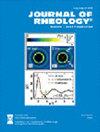三种长度尺度的胶体凝胶:团簇与互穿团簇方法
IF 3.2
2区 工程技术
Q2 MECHANICS
引用次数: 4
摘要
通常,在静止条件下,低体积分数的有吸引力的胶体形成分形凝胶,其结构分为两个长度尺度:胶体尺度和分形簇尺度。然而,当流动干扰凝胶化胶体分形凝胶时,它可能显示出三种不同的长度尺度[Dagès等人,Soft Matter 186645–6659(2022)]。根据最近的实验研究,我们导出了两个模型,解释了这种非典型胶体凝胶的结构和流变特性。凝胶弹性是根据标度参数推断的,并且根据Beaucage提出的全局散射函数方法将结构转换为散射强度,通常在小角度x射线散射(SAXS)中测量。在这两个模型中,我们都认为胶体凝结成分形团簇。在聚类模型的聚类中,聚类形成超聚类,然后构建凝胶网络。在互穿团簇模型中,团簇相互互穿形成凝胶网络。然后使用这两个模型来分析在通过流动停止形成的炭黑凝胶上进行的流变SAXS实验。本文章由计算机程序翻译,如有差异,请以英文原文为准。
Three length-scales colloidal gels: The clusters of clusters versus the interpenetrating clusters approach
Typically, in quiescent conditions, attractive colloids at low volume fractions form fractal gels structured into two length scales: the colloidal and the fractal cluster scales. However, when flow interferes with gelation colloidal fractal gels, it may display three distinct length scales [Dagès et al., Soft Matter 18, 6645–6659 (2022)]. Following those recent experimental investigations, we derive two models that account for the structure and the rheological properties of such atypical colloidal gels. The gel elasticity is inferred from scaling arguments, and the structure is translated into scattering intensities following the global scattering functions approach proposed by Beaucage and, typically, measured in small-angle x-ray scattering (SAXS). In both models, we consider that the colloids condensate into fractal clusters. In the clusters of the clusters model, the clusters form superagregates that then build the gel network. In the interpenetrating clusters model, the clusters interpenetrate one another to form the gel network. Those two models are then used to analyze rheo-SAXS experiments carried out on carbon black gels formed through flow cessation.
求助全文
通过发布文献求助,成功后即可免费获取论文全文。
去求助
来源期刊

Journal of Rheology
物理-力学
CiteScore
6.60
自引率
12.10%
发文量
100
审稿时长
1 months
期刊介绍:
The Journal of Rheology, formerly the Transactions of The Society of Rheology, is published six times per year by The Society of Rheology, a member society of the American Institute of Physics, through AIP Publishing. It provides in-depth interdisciplinary coverage of theoretical and experimental issues drawn from industry and academia. The Journal of Rheology is published for professionals and students in chemistry, physics, engineering, material science, and mathematics.
 求助内容:
求助内容: 应助结果提醒方式:
应助结果提醒方式:


